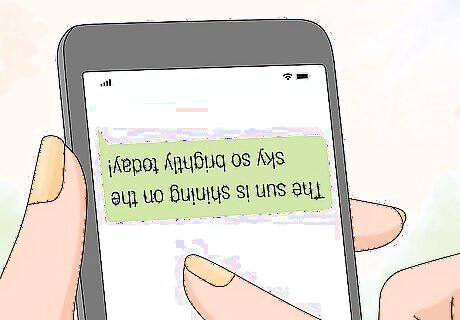
views
Using Subtle Confusion Tactics

Use long, complicated sentences. Prepare these in advance, so you can say them quickly as though they were part of a natural conversation. These sentences and words make sense, but many people will not be able to untangle the meaning. Here are a few that you can adapt to other subjects: "I wouldn't be talking to you about this if I didn't think that I wasn't alone in my views." (An unnecessary amount of negatives, meaning "I think we agree.") "The government plans to raise taxes were defeated." (The word "government" and the word "plans" can both be two parts of speech, and the listener must switch their interpretation halfway through.) "Money is better than poverty, if only for financial reasons." (A meaningless truth.)

Drop references to obscure connections. For example, say "That reminds me of my father's ex-roommate's friend's dog who loves eating samosas." You can make up these connections, or trace actual paths to friends or family you know. If you want to trigger mild surprise or a laugh, this is a good tactic to choose.

Use complex vocabulary. Expand your vocabulary and practice slipping unnecessarily lengthy or obscure words into a conversation. This is more likely to work on people who don't know you well, and on people who don't have a larger vocabulary than you. Here are a few example sentences: "It's a good idea, but could you iterate on the excogitation?" (Could you think it through again in more detail?) "Velleity led me here, but I had a convivial experience." (I came here on a whim, but I had a pleasant time.)

Pretend you have an in-joke with someone. When in a group conversation, choose one of the people you're talking to and act as though you both know an incredible secret. Occasionally, when a different person makes an ordinary remark, turn to the selected person and laugh, wink, or nudge them. This works best if the other person is in on the joke, but with practice and finesse you can keep a conversation moving fast enough that an unwitting target doesn't have a chance to deny the in-joke.
Using Wacky Confusion Tactics

Prepare silly or non-sequitur answers. A non-sequitur is a response that doesn't follow from the conversations or answers preceding it. Here are a few examples of common questions or greetings, along with confusing responses you can use: "Hi, how are you?" — "You're the first person to say that to me. What does it mean?" "Excuse me, do you have the time?" — "No, but I saw it flying that way a few minutes ago." "(any sentence with a technical term or proper noun)" — "Sorry, I'm not really into Pokémon." "Good morning" — (angrily) "I can't believe you got arrested tomorrow!" — "What?" — (cheerily) "Good chatting with you, talk to you later!"

Ask for ridiculous favors, then act offended when refused. For example, ask a stranger to lend you her shoes, let you adopt her dog, or help you install your electric lines. When she refuses, stare at her with an expression of shock, mutter "people these days," and walk away. Say "kids these days" instead, but only when talking to someone clearly older than yourself.

Carry out confusing physical actions. This works best if you act and talk as though you were completely normal, then surprise people with one of the following actions: Drop to the floor and crawl or crab-walk away. Graham Chapman of Monty Python used to crawl around at important dinner functions and rub against people's legs. Stand at attention and salute someone. Bonus points if you set your cell phone to play your country's national anthem.

Confuse someone by altering their room. Ask someone who lives in your friend's house to let you and your assistants in while they're away. Prank your friend with confusing alterations to their room. This prank is best reserved for very close friends, with a good sense of humor. Photograph their room, take everything out of it, then return it exactly the way it was before... in a perfect mirror image. Wrap every object in the room with newspaper, including the furniture.
Confusing Passersby in Public

Fill a mayonnaise jar with yogurt. Clean an empty mayonnaise jar with the label still attached, then fill it with yogurt. Take it to a public park or cafeteria and eat it enthusiastically by the spoonful.

Fill a spray bottle with blue sports drink. Glue on a Windex label or other cleaning product label. Spray it onto your car window or another object, wiping it off with a rag. Spray it into your mouth occasionally, while someone is watching. Using an actual Windex bottle is not recommended, unless you are certain it is thoroughly washed.

Walk around wearing a hand puppet. Act as though you have nothing on your hand, eating, shaking hands, and so forth as normal. After one or more people have been watching you for several minutes, pretend to be surprised by the puppet, scream loudly, and run away with the hand puppet "chasing" you. This works with any unexpected object as well. Try searching thrift shops, antique stores, and yard sales for eerie-looking statuettes.

Post fake signs in public. Many pranksters have copied the visual style of signs found in subways, on telephone poles, or elsewhere, then altered the words or pictures to include silly messages. Be aware that placing these signs on property that isn't yours may attract the attention of police or employees, and is illegal in some locales.

Act as though you have a poorly-kept secret. Pretend you are an incompetent spy, a time traveler, or a lunatic. For maximum confusion, begin by acting relatively normal, and drop increasingly bizarre hints about your "true nature." Here are example scenarios: Dress in a futuristic, silver suit, or other sci-fi style. Act confused around everyday objects, for instance by smelling a mobile phone or attempting to get on a bicycle upside-down. Carry on an ordinary conversation, but include longer and longer pauses before your replies. Start giggling for no reason, then abruptly put on a serious expression and say "I need to return to the asylum now." and walk away backwards.

Plan a public sketch or flash mob. It's easy to earn a few confused glances, but with extra effort, you can transform them into laughter and applause — without sacrificing the confusion, of course. Here's some advice to get you started: For a public comedy sketch, begin with one person dressed in a bizarre costume or doing something unusual, attracting attention while pretending that nothing is unusual. After a few minutes, have one or more other characters show up and talk to the first person loudly. Organize a flash mob to rush in on a certain location and dance, sing, or perform another communal activity. Check Improv Everywhere for upcoming events you can join in your area.
Confusing People Over Text or Email

Pretend to offload a major chore or disaster on someone. Send a text to your partner, friend, or family member, casually describing a major task you need them to do. For example: "Hi, some internet friends from (distant country) are in town, but I decided to relax today. I told them you could show them around instead, maybe drive them to (nearby city)? They'll be at your house soon." (To a friend about to return from vacation) "Welcome home! Thanks for letting me stay in your house. I'm borrowing your clothes for a few more days, but I'll return the stained ones by the end of the week."

Hold a conversation as though the other person were saying something completely different. Have a text conversation, but ignore all the replies from the other person. Instead, send this sequence of messages, waiting for at least thirty seconds between each one. Hey, where are you? Yeah, almost ready. I don't think he knows anything. It's happening in a few minutes. You definitely said grapefruit juice. Susan's bringing the ramp. Wait, is this going to (other person's name) too? Cancel everything, we'll move it to next week.

Distract someone with confusing questions. Ask silly questions, or riddles with trick answers: "If a cat always lands on its feet, and toast always lands butter-side-down, what happens when you tie toast to a cat's back?" "If a plane crashes in Antarctica, in what country are the survivors buried?" (Answer: Why do you want to bury a survivor?)

Send upside-down messages. Visit an upside-down text flipper, and type in your message. This will convert your message into upside-down text. Not all chat programs, email applications, and browsers can display these characters, so the person you send it too might only see a row of squares or question marks.




















Comments
0 comment